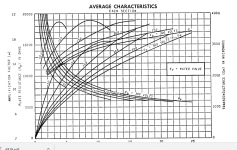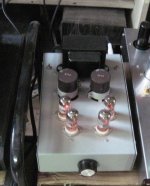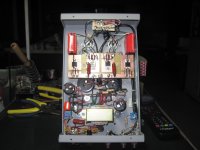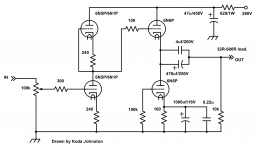Hi gabdx,
I actually work with tubes, transistors and low level signals. I'm even trained for this and have gone to university.
If you read the wrong texts you can certainly come to this incorrect conclusion. Tubes will never come close to the noise performance of solid state devices. Not even if you cryo-treat them.
Now, if you were to say that you prefer tube electronics over solid state electronics I couldn't have an argument. It's just your preference.
So. Find some books related to low level signals that are technical in nature. Don't bother with "white papers" (they are advertising only). Then, once you have read enough, buy some equipment and actually build these things. Then you will know the truth. Even Morgan Jones will tell you that solid state is less noisy. He has an excellent book out BTW.
-Chris
I actually work with tubes, transistors and low level signals. I'm even trained for this and have gone to university.
If you read the wrong texts you can certainly come to this incorrect conclusion. Tubes will never come close to the noise performance of solid state devices. Not even if you cryo-treat them.
Now, if you were to say that you prefer tube electronics over solid state electronics I couldn't have an argument. It's just your preference.
So. Find some books related to low level signals that are technical in nature. Don't bother with "white papers" (they are advertising only). Then, once you have read enough, buy some equipment and actually build these things. Then you will know the truth. Even Morgan Jones will tell you that solid state is less noisy. He has an excellent book out BTW.
-Chris
This proves tubes are way superior to transistors, the *au7 can drive powerful amplifiers signals.
I think in a real world amplifier the distortion figures are a lot worse because of the shared power supply with the main rectification variations.
In this test with the powerful regulated bench power supply the tube supply is unwavering and can show what the tube is capable in an optimized situation.
Many tubes are good like the *au7 and can be used in the Aikido.
let us not get into this "superior" thingy,
bipolar trannies in small signal have higher transconductance, 1/re. where re = 26mv/ie, ie being the emitter current in milliamps...
so at 1mA, any bjt will have a gm of 1/26...
compare that with the gm of the 12au7 at 1 ma/100v plate....800mhos
btw, our listening tests has demonstrated the broskie's ccda sound better than the broskie aikido...take note that this are mere listening tests...
Attachments
TonyTecson , I don't see your point.
1. no one would bias a phono stage at 1ma...
2. no one would use a 12au7 in a phono input or gain.
3. in the aikido, I had the manual, the bias are not near 1ma...
4. I don't think the CCDA can even compare to the aikido...
i am not surprised that you did not see the point...
i am merely reacting on your comparison between a solid state and a tube..
i used the 1ma as reference to compare transconductance...for convenience....
1. i suggest that you look at a lot of other circuits, the 12ax7 can be biased at 1ma or less, that depends on the designer,
2. i never said use the 12au7 as input nor gain stage, the tube mu at 20 is far too low, that is why the 12ax7 with its mu of 100 or the 12at7 with its mu of 60 gets called..
3. in an aikido with 12au7 tubes, why would anyone bias that at 1ma? i will not...but you are welcome to try...
4. the ccda was subject to listening tests in comparison with the aikido, it is not my fault that people simply liked the ccda better...if you like the aikido better, and is happy with it, then i am happy for you...
please read my post carefully i am sure you can find something there...
Hi gabdx,
I actually work with tubes, transistors and low level signals. I'm even trained for this and have gone to university.
If you read the wrong texts you can certainly come to this incorrect conclusion. Tubes will never come close to the noise performance of solid state devices. Not even if you cryo-treat them.
Now, if you were to say that you prefer tube electronics over solid state electronics I couldn't have an argument. It's just your preference.
So. Find some books related to low level signals that are technical in nature. Don't bother with "white papers" (they are advertising only). Then, once you have read enough, buy some equipment and actually build these things. Then you will know the truth. Even Morgan Jones will tell you that solid state is less noisy. He has an excellent book out BTW.
-Chris
yes Chris, tubes are noisier, but they can be made as quiet as can be depending on how savvy the designer is...there are known tricks for doing that...
As I said, valves are noisy because they have a hot cathode and hence a hot cathode space charge. This is unavoidable, however clever the circuit designer. Reduce the cathode temperature a little and you get a small noise advantage; reduce it further and you lose space charge smoothing so then you get increased shot noise. There are no tricks for adopting alternative physics.
Tubes are not superior just different.
too much tube yields a soft mushy sound, the right amount of tube distortion makes a recording sound live. You can't really see it on a scope but the sound is there, I have an op275 (0.0003% THD ) set for a gain of 10 and the 6922 set the same. performing an A-B test the 6922 sounds fuller. Niether amp has any capacitor added that would effect any signals up to 100khz.
too much tube yields a soft mushy sound, the right amount of tube distortion makes a recording sound live. You can't really see it on a scope but the sound is there, I have an op275 (0.0003% THD ) set for a gain of 10 and the 6922 set the same. performing an A-B test the 6922 sounds fuller. Niether amp has any capacitor added that would effect any signals up to 100khz.
As I said, valves are noisy because they have a hot cathode and hence a hot cathode space charge. This is unavoidable, however clever the circuit designer. Reduce the cathode temperature a little and you get a small noise advantage; reduce it further and you lose space charge smoothing so then you get increased shot noise. There are no tricks for adopting alternative physics.
agreed and understood...
Tubes are not superior just different.
too much tube yields a soft mushy sound, the right amount of tube distortion makes a recording sound live. You can't really see it on a scope but the sound is there, I have an op275 (0.0003% THD ) set for a gain of 10 and the 6922 set the same. performing an A-B test the 6922 sounds fuller. Niether amp has any capacitor added that would effect any signals up to 100khz.
i live and breath tubes, i am a tubehead....
i like tubes not for the claimed superiority, that is a myth...
you should try the Russian 6h23, a listening test pitting it against the
6dj8 "bugle boy", and guess what? an oldtimer liked the 6h23 better...
Anatoly suggested that tube to me and he was right......
To be honest I took a look at the CCDA again, I have never used this circuit. However I used similar circuits with CCS and Drains with transistors and even the perfect 'circuit' the pre-amp bloomed with harmonics and coloration.
The aikido circuit sounds warm, with an extra transistor it sounds very neutral and performs flawlessly, I am not even interested to hear anything else.
Never had a good experience with 6n6p/6n2p, 6n1, excep the 6h9c , I find the old Russian tubes to be very warm. however 6h9c fits well into low power amps to replace costly 6sl7s.
I prefer by far GE jan 6922 which is very holographic and perfect.
However if the Russian fits your sound needs they are very cheap and a no brainer.
The aikido circuit sounds warm, with an extra transistor it sounds very neutral and performs flawlessly, I am not even interested to hear anything else.
Never had a good experience with 6n6p/6n2p, 6n1, excep the 6h9c , I find the old Russian tubes to be very warm. however 6h9c fits well into low power amps to replace costly 6sl7s.
I prefer by far GE jan 6922 which is very holographic and perfect.
However if the Russian fits your sound needs they are very cheap and a no brainer.
My go to for Aikido line stage is 6N3P. If I build for 32R+ headphones, I use 6N3P/6N6P. I avoid 12A*7 and 6DJ8, and in my Aikido phono stage I used 6N3P,6N3P,6N2P,6N3P.
As for my CCDA Phono I used 6N1P/12AT7 and it's not bad. CCDA line I use 6N3P/5670, 6N1P, or 6CG7.
My next Aikido I will try 6N14P.
Has anyone tried the 6N4J? It seems like it's a Chinese 12AX7 but probably 9AJ pinout.
As for my CCDA Phono I used 6N1P/12AT7 and it's not bad. CCDA line I use 6N3P/5670, 6N1P, or 6CG7.
My next Aikido I will try 6N14P.
Has anyone tried the 6N4J? It seems like it's a Chinese 12AX7 but probably 9AJ pinout.
You are right that the cost is high at 40 over for one tube... I like peace of mind.
I have a 100 soviet box of 6n6p, I will never use them because they **** in my opinion, I had high hopes for them in DAC, IV, Pre-amp, Amps, and they let me down! terribly.
That's odd to me. I've used them many times and they've always worked great. What was your operating point?
Here's the circuit I mainly used them in. I think you will like it if you build it.
I even made a PPP 5W amp with 4 of them. Wanna swap some for some NOS Sylvania 6DJ8?
Attachments
Last edited:
Nice build, Tony.this is a 4kn8 broskie ccda that mimiks an aikido....
tube sections paralleled and IXYS mosfets run at >12mA....
i like it although gain is a bit high....this is my main preamp for years now...
- Home
- Amplifiers
- Tubes / Valves
- Survey: Aikido distortion



